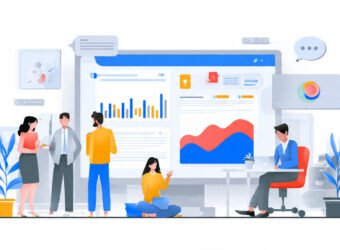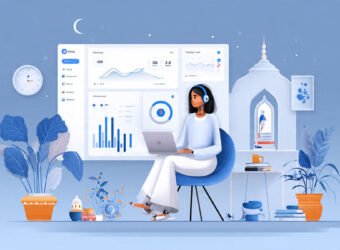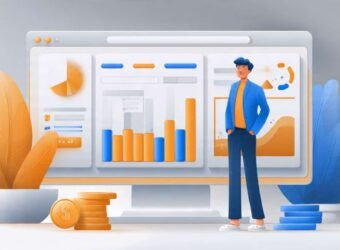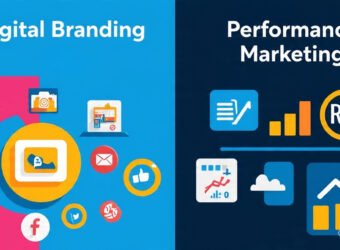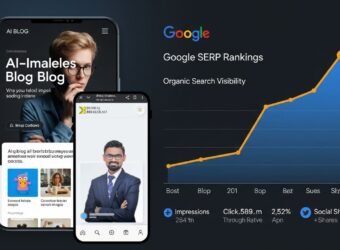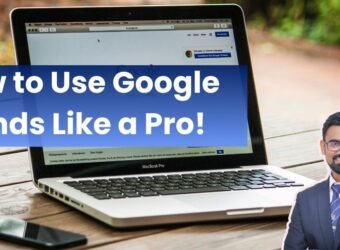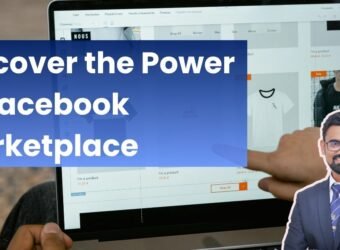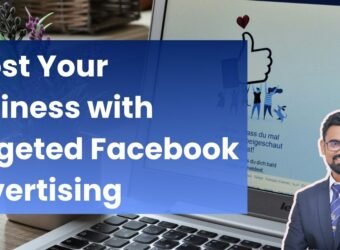
How Agentic AI Can Automate Content Creation, Posting, and Performance Tracking
If you’ve ever ordered groceries on an app during rush hour, you know the magic of automation.
You add items, the system picks substitutes, payment happens via UPI, and delivery arrives without you micromanaging anything.
Now imagine your content marketing working exactly like that.
No back-and-forth.
No approvals stuck in someone’s inbox.
No manual posting at 9:30 PM because “Instagram peak reach”.
Just a smooth, self-running engine that knows what to create, when to publish, and how to track results.
That is the promise of Agentic AI.
Agentic AI refers to AI systems that act on behalf of the user, taking decisions, performing tasks autonomously, and optimising outcomes without constant human intervention.
In simple words:
Agentic AI is like having a smart marketing manager who works 24×7 and never takes a break.
Instead of prompts → output, it works on:
Goal → autonomous actions → continuous improvement
Especially in India
Why It Matters
In India’s fast-moving digital landscape, the content cycle is unforgiving.
Brands juggle:
- High competition in every category
- Short attention spans
- Tier-2/Tier-3 audience diversity
- Festival-heavy spikes in demand
- Mobile-first consumption
- Cost-sensitive performance expectations
With AI alone, teams still struggle with execution gaps.
But with Agentic AI, the system doesn’t just create—it runs the workflow.
Imagine content that knows:
- When IPL conversation is heating up
- When festive search volume spikes
- When your CPC is rising
- When your last reel underperformed
- And automatically adjusts your strategy
This is where India’s marketing ecosystem will see the biggest leap in efficiency.
Benefits / Business Outcomes
Here’s what businesses gain when they adopt agentic AI workflows:
1. Faster Content Creation
From ideation to scriptwriting to design variants—all generated within minutes.
2. Automated Posting & Scheduling
Posts go live based on audience behaviour, not human availability.
3. Reduced Wastage
AI learns what doesn’t work and stops repeating low-performing formats.
4. Higher ROI
Focused content + optimised timing = better reach and lower acquisition cost.
5. Real-Time Performance Tracking
No waiting for Monday reports.
Dashboards update instantly and trigger corrective actions.
6. Consistent Brand Presence
Even small teams look large because the system fills execution gaps automatically.
How to Use / Implement Agentic AI

Practical Summary
- What it is: AI that takes autonomous actions, not just generates content.
- Why it matters: India’s fast, festival-led, mobile-first market needs speed and precision.
- Key benefits: Better ROI, reduced manual work, continuous optimisation.
- Indian relevance: Perfect for multichannel, multilingual, cost-sensitive environments.
Conclusion
Just like your grocery app quietly coordinates inventory, substitutions, payments, and delivery…
Agentic AI quietly coordinates your content creation, posting, and performance optimisation.
You set the goal.
It runs the system.
And over time, it becomes sharper, faster, and more aligned with your brand.
The future of marketing isn’t just AI-generated content.
It’s AI-managed content workflows.

AI-Driven Creative Testing: How Agents Can Design, Test, and Scale Ads in Real Time
Have you ever ordered pani puri from a busy street stall?
The vendor keeps adjusting the spice, the tanginess, the filling — all based on how people react. One wince? Less spice. Someone asks for “extra teekha”? He adapts instantly. That’s why his stall always has a queue.
Real-time feedback. Real-time optimisation.
Now imagine your ads could behave exactly like that vendor — learning, tweaking, and improving every minute.
That’s precisely what AI-driven creative testing with autonomous agents makes possible.

What Is AI-Driven Creative Testing in Simple Terms?
AI-driven creative testing is the process where AI agents design, analyse, and optimise ad creatives at scale, without you manually building dozens of versions.
In simple words:
AI-driven creative testing is like having a super-fast marketing chef who keeps tweaking the recipe until customers love it.
These agents don’t wait for weekly reports. They learn from every impression.
Why It Matters (Especially in India)
India’s digital landscape moves at IPL pace.
Consumers swipe fast, attention is low, and competition is intense — especially on Meta, Google, Amazon, ONDC, and OTT ad placements.
Here’s why AI agents matter in this environment:
Cost sensitivity
Indian brands can’t afford wasted ad spend; AI avoids unprofitable creative bets.
Tier-2/Tier-3 expansion
Different cities respond to different tones, colours, languages. AI learns these nuances instantly.
Festive cycles
Diwali to IPL — consumer behaviour shifts quickly. Agents adapt faster than manual teams.
Mobile-first reality
Most users see ads in seconds; the right creative can double performance.
High-volume data
With billions of impressions on UPI-powered commerce journeys, AI thrives on real-time signals.
Benefits & Business Outcomes
Here’s what businesses gain when creative testing becomes AI-driven:
- Higher ROI: Ads improve continuously instead of waiting for a campaign review cycle.
- Reduced wastage: Poor creatives are paused instantly — no emotional or manual bias.
- Better targeting synergy: Agents connect creative elements with audience pockets that respond best.
- Speed: What once took 3–4 weeks now happens in a few hours.
- Scalability: Build 100 creative variations without exhausting your design team.
Consistency: AI never forgets learnings; performance stays on track even if teams change.

How to Use / Implement It
Here is a simple framework to get started:
- Define a clear goal Is it CTR uplift? Lower CPA? Better add-to-cart rate? Tell the agent.
- Choose the right tools or platforms Meta Advantage+, Google Performance Max, specialised AI creative tools, or custom agent frameworks.
- Start small Pick one product line, one city, or one ad format. Let the AI learn.
- Measure what matters Look at creative-level insights: colours, headlines, CTAs, hooks, offers.
- Optimise continuously Feed the agent better briefs, new angles, fresh brand guidelines — it keeps improving.
Practical Summary
- What it is: Automated creative design + testing using AI agents.
- Why it matters: Speeds up optimisation, reduces cost, increases performance.
- Key benefits: Real-time learning, scalability, reduced wastage, higher ROI.
- Indian relevance: Works perfectly for fast-changing, high-volume, mobile-first markets.
Conclusion
Just like that pani puri vendor who adjusts flavours with every customer, AI agents adjust your creatives with every impression.
The result?
Your ads become more relevant, more engaging, and more profitable — not because you worked harder, but because your system kept learning.
Real-time optimisation isn’t the future.
It’s already here. And brands that adopt it now will stay forever ahead in the queue.
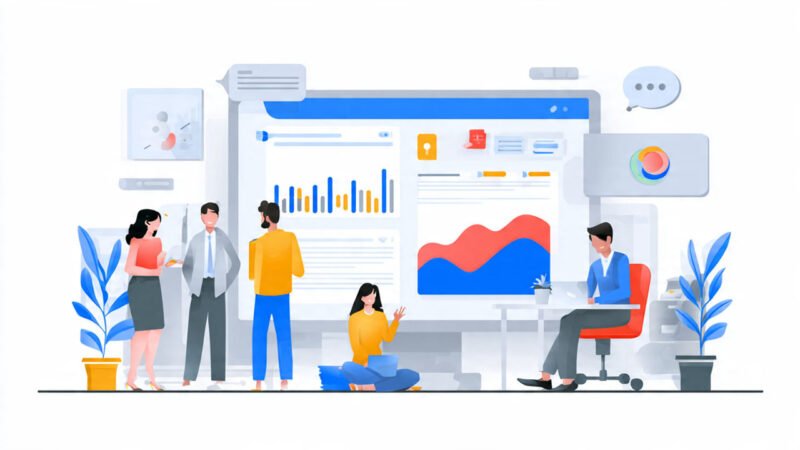
How to Integrate Agentic AI into Your Existing Marketing Stack Without Disruptions
Imagine you’re upgrading your smartphone. You don’t throw away all your apps, contacts, and settings—you simply add new features to make it smarter and more efficient. Similarly, when it comes to marketing, you don’t have to replace your entire system to adopt Agentic AI. Instead, you can integrate it seamlessly into your existing stack, ensuring continuity and better results.
What is Agentic AI in Marketing?
Agentic AI is a new wave of artificial intelligence that doesn’t just analyze data but takes proactive steps to achieve marketing goals. Unlike traditional AI, which only responds to prompts, Agentic AI can plan, act, and adjust in real time. For Indian businesses—whether startups, SMEs, or large enterprises—this means smarter campaigns, reduced manual effort, and improved ROI.
Why Integration Matters
Integrating Agentic AI is like adding turbo boosters to your car—you get speed and efficiency without changing the vehicle. But marketers often worry: Will this disrupt my current tools like CRM, analytics dashboards, or ad platforms? The good news is, with the right approach, you can integrate Agentic AI smoothly, keeping your team productive and your data safe.
Steps to Seamlessly Integrate Agentic AI
Step 1: Start with Clear Goals
Before adopting Agentic AI, define what you want to achieve—better lead nurturing, higher ad conversions, or faster reporting. Clear goals guide the integration process and avoid confusion.
Step 2: Audit Your Current Marketing Stack
Evaluate the tools you’re already using: CRM (Zoho, HubSpot), email automation (Mailchimp, Sendinblue), or analytics (Google Analytics, Mixpanel). Identify gaps where Agentic AI can add value without duplicating functions.
Step 3: Choose Plug-and-Play Solutions
Look for Agentic AI tools that offer API compatibility or ready-made integrations with platforms popular in India—like Shopify for eCommerce, WhatsApp Business API for communication, or Meta Ads for social campaigns. This ensures minimal disruption.
Step 4: Train Teams Gradually
Instead of rolling out AI across all campaigns, start with one use case—say automated lead scoring or personalized email campaigns. Allow teams to learn and adapt before expanding.
Step 5: Monitor, Test, and Scale
Like any strategy, integration needs testing. Use A/B experiments to measure impact, track KPIs, and then scale up once results are proven.
Benefits of Integrating Agentic AI
-
Efficiency Boost: Automates repetitive tasks, freeing marketers to focus on strategy. -
Personalization: Delivers targeted campaigns based on real-time user behavior. -
Cost-Effective: Optimizes ad spends by dynamically adjusting bids and targeting. -
Scalability: Works well across industries—retail, education, fintech, or healthcare.
For Indian companies operating in competitive markets, this blend of automation and adaptability can be the edge that drives consistent growth.
Final Takeaway
Integrating Agentic AI into your marketing stack is not about starting from scratch. It’s about making your existing tools smarter, your campaigns more efficient, and your customer journeys more personalized. Start small, measure impact, and scale gradually. Done right, Agentic AI can become the silent growth partner in your marketing ecosystem.

Agentic AI vs. Traditional AI in Marketing: Key Differences and Benefits
Introduction: The Kashmir Tour Analogy
Imagine you’re planning a dream trip to Kashmir. You have two tour planners.
The first one — a traditional planner — follows your exact instructions: you tell them where to stay, what to eat, and which places to visit. They’re efficient, but only within the scope of your guidance.
Now, meet the agentic planner — they go beyond instructions. They anticipate bad weather and rearrange your itinerary, suggest hidden gems off the tourist map, and even handle last-minute changes without bothering you.
That’s the real difference between Traditional AI and Agentic AI in marketing. One waits for direction; the other takes initiative.

What Is Traditional AI in Marketing?
Traditional AI is like your first Kashmir planner. It works within a fixed framework. It analyzes data, predicts trends, and executes commands — but it doesn’t “think” beyond what it’s told.
It’s the backbone of marketing automation tools we’ve known for years: chatbots, product recommendation systems, or ad optimizers. These systems help, but they rely heavily on human guidance.
Key Traits of Traditional AI:
-
Follows predefined rules and commands. -
Relies on human supervision for updates and corrections. -
Automates repetitive tasks like email scheduling or ad placement. -
Offers efficiency but lacks initiative.
So, while Traditional AI helps marketers save time, it’s still like a tour planner waiting for you to decide the next move.

The Smart Kashmir Planner: Understanding Agentic AI
Agentic AI, on the other hand, is your proactive Kashmir tour planner — it doesn’t just wait for instructions; it acts on behalf of you.
In marketing, Agentic AI is capable of setting goals, making real-time decisions, and executing multi-channel campaigns without constant human input. It understands your brand objectives, adapts to market shifts, and continuously optimizes performance.
For instance, imagine an Indian e-commerce brand using Agentic AI. It automatically plans ad strategies across Meta, Google, and Amazon Ads, monitors conversions, reallocates budgets, and adjusts creatives — all without the marketer lifting a finger.
Key Traits of Agentic AI:
-
Autonomous and proactive in decision-making. -
Executes marketing campaigns from start to finish. -
Adapts dynamically to market trends and customer behavior. -
Reduces the need for constant human intervention.

Agentic AI vs. Traditional AI: Key Differences
Aspect | Traditional AI | Agentic AI |
Decision-making | Works on fixed inputs | Takes initiative based on goals |
Flexibility | Limited to pre-set patterns | Adapts to new situations |
Human Involvement | Needs constant supervision | Operates autonomously |
Learning Capability | Dependent on provided data | Learns continuously from live data |
Scope | Task automation | Strategic execution and optimization |
Why This Matters for Indian Marketers
India’s digital marketing space is buzzing — with startups, D2C brands, and SMEs racing for attention online. Traditional AI tools help automate operations, but they still demand frequent manual tweaks.
Agentic AI changes that game.
It empowers Indian marketers to focus on creativity, storytelling, and strategy while the
India’s digital marketing space is buzzing — with startups, D2C brands, and SMEs racing for attention online. Traditional AI tools help automate operations, but they still demand frequent manual tweaks.
Agentic AI changes that game.
It empowers Indian marketers to focus on creativity, storytelling, and strategy while the

Conclusion: The Smarter Way to Market
Just like you’d prefer a tour planner who manages everything for your Kashmir trip, businesses should adopt Agentic AI to simplify their marketing journeys.
Traditional AI still plays a vital role — it’s reliable and structured. But Agentic AI represents the next evolution — one that can act, learn, and improve without needing constant directions.
So, if you’re an Indian business looking to scale, it’s time to move from AI that follows to AI that leads.
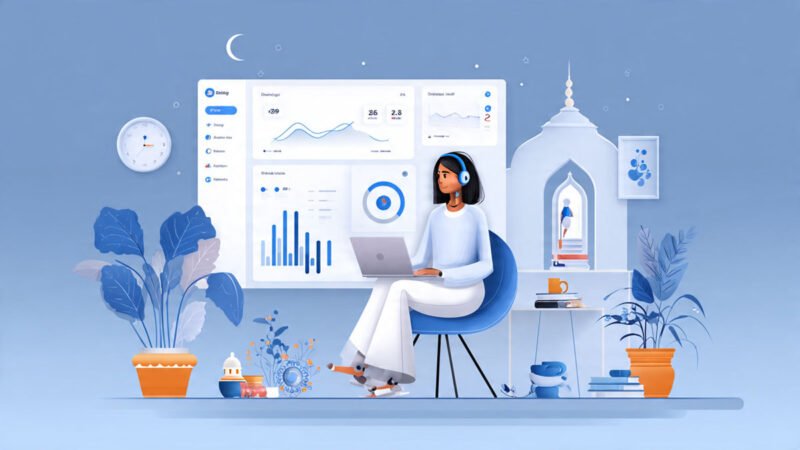
From Prompt to Profit: How Agentic AI Can Run Entire Marketing Campaigns Autonomously
Introduction
Imagine hiring a wedding planner in India—you simply give them your preferences, budget, and guest list, and they handle everything from decorations to catering. You don’t have to run behind vendors, track expenses, or worry about timelines; the planner ensures everything flows smoothly.
Now imagine the same level of convenience applied to your marketing campaigns. You give a clear “prompt” about your goals, and the system automatically designs, executes, monitors, and optimizes the entire campaign. That’s exactly what Agentic AI brings to digital marketing—turning prompts into profits.

Key Benefits of Agentic AI in Marketing
From writing ad copies in multiple Indian languages to scheduling campaigns and tracking conversions, everything can be handled without manual intervention.
Indian audiences are diverse. Agentic AI can tailor ads based on local culture, language, and user behavior—whether you’re targeting a student in Pune or a professional in Bengaluru.
Think of Agentic AI as a smart negotiator in a busy Indian market. It continuously adjusts ad bids, ensuring your money is spent where it brings the highest return.
Instead of waiting for weekly reports, AI monitors campaigns in real time and makes changes instantly—just like a cricket captain adjusting field placements mid-match.
Whether it’s a neighborhood bakery running Facebook ads or a pan-India e-commerce brand, Agentic AI adapts to scale campaigns seamlessly.
From writing ad copies in multiple Indian languages to scheduling campaigns and tracking conversions, everything can be handled without manual intervention.
Indian audiences are diverse. Agentic AI can tailor ads based on local culture, language, and user behavior—whether you’re targeting a student in Pune or a professional in Bengaluru.
Think of Agentic AI as a smart negotiator in a busy Indian market. It continuously adjusts ad bids, ensuring your money is spent where it brings the highest return.
Instead of waiting for weekly reports, AI monitors campaigns in real time and makes changes instantly—just like a cricket captain adjusting field placements mid-match.
Whether it’s a neighborhood bakery running Facebook ads or a pan-India e-commerce brand, Agentic AI adapts to scale campaigns seamlessly.
Why Does This Matter for Indian Businesses?
India’s digital marketing landscape is growing rapidly, with small businesses, startups, and enterprises all competing for visibility. Yet, most face challenges such as:
-
Limited budgets, -
Lack of skilled manpower, and -
High competition for attention
Agentic AI levels the playing field by offering enterprise-level campaign efficiency at a fraction of the cost.

Real-World Relevance
-
Small Business Example: A local clothing brand in Delhi can give Agentic AI a prompt like, “Promote my new festive collection to women aged 20–35 in North India.” The AI will create tailored Instagram ads, set budgets, track engagement, and suggest influencer collaborations. -
Corporate Example: An IT company in Bengaluru can prompt the AI with “Generate 500 B2B leads in 90 days.” The system will plan LinkedIn campaigns, build landing pages, and optimize for conversions—all automatically.

The Road Ahead
Agentic AI isn’t just about saving time—it’s about unlocking growth. As adoption grows in India, we can expect marketing teams to shift from tactical execution to strategic innovation, with AI handling the heavy lifting.
Conclusion
Just like hiring a reliable wedding planner ensures a stress-free event, Agentic AI ensures your marketing campaigns run smoothly—from the first prompt to measurable profit. For Indian businesses, this technology isn’t just the future—it’s the present. Those who adopt it early will enjoy smarter, faster, and more cost-effective campaigns.

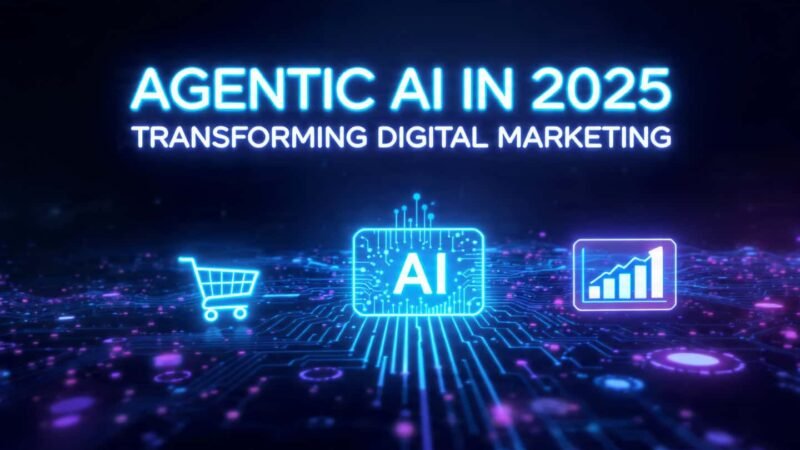
What is Agentic AI and How It’s Transforming Digital Marketing in 2025
Introduction: The Chaiwala Analogy
Imagine visiting your regular chaiwala in the morning. You don’t even need to tell him your order anymore—he remembers how much sugar you like, whether you prefer masala or plain, and even anticipates when you’re running late. Now, imagine if your digital marketing worked with the same intelligence—understanding customer preferences, predicting actions, and delivering results without you constantly giving instructions. That’s exactly what Agentic AI is bringing to businesses in 2025.
https://youtu.be/bIbWBPuua4c
What is Agentic AI?
In simple terms, Agentic AI refers to artificial intelligence systems that act like “agents”—they don’t just respond to instructions but can think, decide, and act independently. Unlike traditional AI, which waits for prompts, agentic AI systems can set goals, take actions, learn from outcomes, and continuously optimize results without constant human intervention.
In digital marketing, this means AI tools are no longer just assistants—they’re becoming proactive partners, capable of managing campaigns, analyzing customer journeys, and even experimenting with strategies in real time.
How Agentic AI is Transforming Digital Marketing in 2025
1. Hyper-Personalization at Scale
Agentic AI can understand customer behavior deeply—what they like, when they engage, and even their buying intent.
Example: An Indian e-commerce brand selling festive outfits might see Google’s AI dynamically showing “Kurta Sets for Navratri” to one user and “Designer Sarees for Diwali” to another—each aligned with their preferences.
2. Autonomous Campaign Management
Instead of marketers manually setting ad budgets, testing creatives, and tracking KPIs, agentic AI can run this entire cycle automatically. It’s like having a marketing manager that never sleeps. Indian startups, especially in Tier-2 and Tier-3 cities, can use this to compete with big brands without needing massive teams.
Example: Google’s Performance Max leverages agentic capabilities to autonomously test headlines, images, and videos across YouTube, Search, and Display. For a D2C skincare brand in Mumbai, the AI decides which creative performs best for each audience, reallocating budgets on its own—maximizing ROI without manual tweaks.
3. Real-Time Decision Making
In India’s fast-moving digital economy, trends can change overnight. Agentic AI allows businesses to pivot instantly—whether it’s shifting ad spend to trending products or adjusting content to align with a sudden cricket craze.
Example: If a sportswear brand notices a surge in searches for “India jersey 2025” before a major match, Google’s AI can instantly prioritize relevant campaigns, increase bids, and redirect budgets—making sure ads reach fans at the perfect moment
4. Cost Efficiency
By minimizing human error and optimizing ad spends, agentic AI can help businesses reduce wasted budget. For small Indian businesses operating on tight margins, this could be the difference between breaking even and scaling up.
Example: When paired with Google Ads and AI-powered remarketing, a travel agency can automatically send personalized follow-up ads for “Goa packages under ₹10,000” to users who previously checked beach destinations—keeping them engaged and moving them toward booking.
5. Enhanced Customer Engagement
From WhatsApp chatbots to voice-enabled shopping, agentic AI enables seamless customer interactions. Imagine a travel agency in India where an AI agent books tickets, suggests hotels, and even curates local experiences—all without human involvement.
Why It Matters for Indian Businesses
India’s digital ecosystem is unique: highly diverse, price-sensitive, and mobile-first. Agentic AI is especially powerful here because it allows businesses to do more with less—fewer people, smaller budgets, but smarter execution. Whether you’re a startup in Pune, a D2C brand in Bangalore, or a traditional business going digital in Jaipur, agentic AI can level the playing field.
Practical Summary
-
Agentic AI = AI that thinks, acts, and optimizes independently. -
It helps businesses with personalization, automation, real-time decisions, cost savings, and engagement.
In short, Agentic AI is your chaiwala for digital marketing—always ready, always learning, and always delivering exactly what your customer wants.
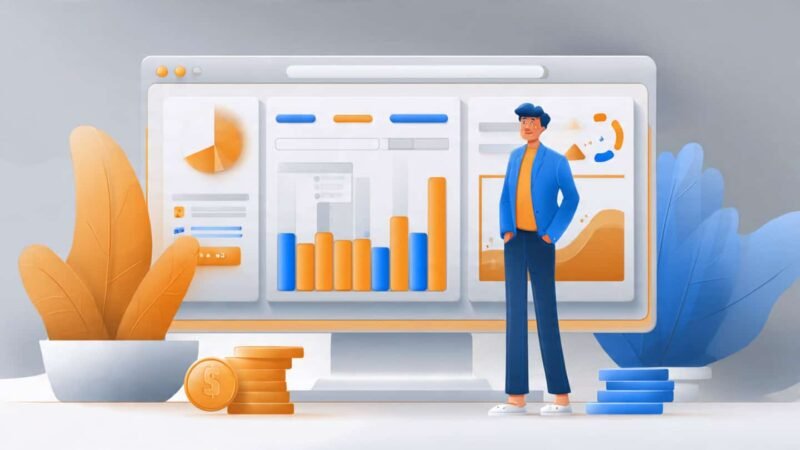
AI in PPC Campaigns: How Machine Learning Can Cut Costs & Boost Conversions
Pay-per-click (PPC) campaigns have always been a cornerstone of digital marketing. But in today’s fast-paced environment, running ads manually isn’t enough. Advertisers need to be faster, smarter, and more data-driven. This is where Artificial Intelligence (AI) and Machine Learning (ML) step in—helping businesses cut costs while increasing conversions.
In this blog, let’s explore how AI is transforming PPC advertising and why Indian businesses should embrace it.
What is AI in PPC?
AI in PPC uses machine learning algorithms to analyze massive amounts of ad data in real time. Instead of guessing which keywords or ad placements will perform best, AI predicts outcomes, automates decisions, and optimizes campaigns continuously.
Think of it as hiring a 24/7 smart assistant that constantly studies your campaigns and tweaks them for better results.
How AI Cuts Costs in PPC
Smarter Bidding Strategies
AI-powered tools like Google’s Smart Bidding adjust bids automatically, ensuring you don’t overspend on low-quality clicks.
Negative Keyword Identification
AI detects irrelevant search terms that waste your budget and excludes them instantly.
Ad Spend Optimisation
Machine learning reallocates budget to top-performing campaigns and pauses underperformers, maximizing ROI.
Predictive Analytics
By analyzing user behavior patterns, AI predicts which keywords or audiences are more likely to convert, reducing money spent on trial and error.
How AI Boosts Conversions
https://vimeo.com/1124609032
Suppose you’re a B2B manufacturing company in India that supplies industrial machinery parts to automotive firms. Traditionally, you might bid on broad terms like “machine parts supplier” and end up attracting clicks from students, small hobbyists, or irrelevant industries. This wastes budget without bringing qualified leads.
With AI-powered PPC
-
The system identifies that decision-makers in mid-sized automotive companies searching for “ISO-certified brake system suppliers” are 4x more likely to convert. -
It automatically shifts budget toward these niche keywords and refines targeting to reach procurement managers on LinkedIn or Google. -
AI also runs predictive retargeting campaigns, showing ads only to businesses that visited your product catalog or downloaded a technical brochure—signaling higher purchase intent. -
Over time, the system learns which industries respond best and prioritizes them, improving lead quality.
Result? Lower cost per lead (CPL), fewer wasted clicks, and a pipeline full of qualified B2B prospects instead of casual browsers.
The Future of AI in PPC
The future lies in predictive campaigns—where AI not only optimizes existing ads but also suggests new creative angles, predicts seasonal demand, and even auto-generates ad content. For Indian businesses competing in crowded markets, this means a significant edge in customer acquisition.
Conclusion
AI is no longer a futuristic concept—it’s the present of PPC advertising. By leveraging machine learning, businesses can spend less and earn more. Whether you’re a startup in Mumbai or a global enterprise, AI-driven PPC campaigns can help you scale efficiently, stay competitive, and achieve higher conversions.
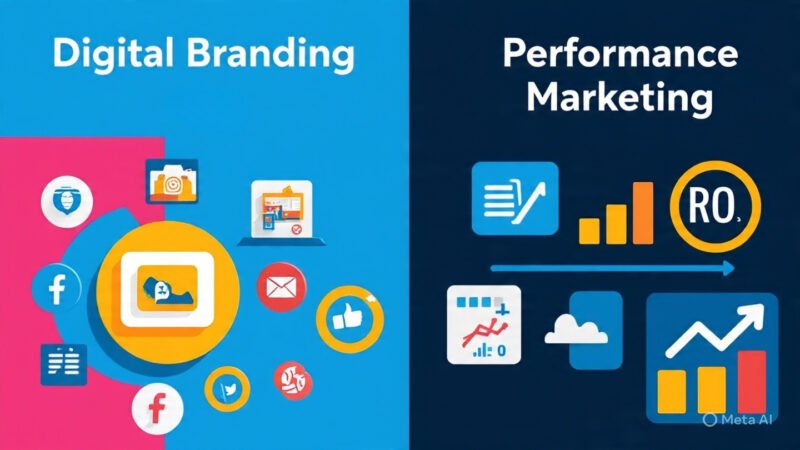
Digital Branding vs. Performance Marketing: Finding the Right Balance
Imagine your business as a car. Performance marketing is the accelerator — it gives you speed, immediate movement, and quick results. Digital branding is the engine — it builds the power, reliability, and endurance for the long journey. If you only press the accelerator without a strong engine, you’ll break down fast. If you only focus on the engine and never accelerate, you won’t move forward. For sustainable growth, your marketing strategy — just like driving a car — needs both speed and power in balance.
Defining the Concepts
Digital Branding is about shaping a brand’s identity, voice, and emotional connection in the online world. It creates awareness, trust, and loyalty through storytelling, social media presence, content marketing, and visual identity.
Performance Marketing, on the other hand, focuses on measurable results. Every spent is linked to clicks, leads, or sales. It uses tactics like paid ads, affiliate marketing, retargeting, and data-driven campaigns.
Why the Balance Matters
Globally, businesses often struggle with extremes. Some invest heavily in branding without immediate ROI, while others rely only on performance campaigns, ignoring long-term trust. Both approaches have downsides:
Too much branding = delayed measurable results and high upfront cost.
Too much performance marketing = quick wins but no customer loyalty.
A balanced approach ensures both brand trust and steady conversions.
Benefits of Digital Branding
Trust Building: Enhances credibility in competitive global markets.
Recognition: Strong identity influences purchasing decisions.
Emotional Loyalty: Customers stay even if competitors offer discounts.
Sustainable ROI: Reduces reliance on aggressive ad spend.
Benefits of Performance Marketing
Measurable ROI: Every campaign is trackable.
Speed: Delivers leads and conversions quickly.
Scalability: Budgets can be increased or decreased instantly.
Precision Targeting: Ads reach defined demographics, interests, and geographies.
How to Find the Right Balance
Define Goals Clearly
1. Want awareness? Prioritize branding.
2. Need immediate sales? Push performance campaigns.
Budget Allocation
A common starting point: 60% performance marketing and 40% branding — then adjust based on results.
Integrate Both Approaches
Branding campaigns warm up audiences. Performance ads convert them.
Example: Run a brand storytelling video → Retarget viewers with a special offer.
Track & Optimize
Use analytics to connect branding efforts with performance outcomes. Stronger branding often lowers acquisition costs.
Practical Summary
Just like a car needs both a powerful engine and a responsive accelerator, your marketing strategy needs digital branding for long-term strength and performance marketing for immediate results. In today’s global, highly competitive environment, the right balance ensures that you not only move fast but also reach your destination reliably.
Start with clear objectives, balance your investments, and let data guide you. The most successful brands combine recognition with measurable ROI — and that’s the road to sustainable growth.

B2B Lead Generation Strategies That Actually Deliver ROI
Have you ever gone grocery shopping without a list? You wander around, pick random items and end up with a bill that doesn’t match your needs. This is exactly what happens when businesses try to generate leads without a clear strategy — wasted effort, wasted money and no measurable results.
In B2B, every lead counts. Unlike B2C where volume can sometimes offset low conversions, B2B lead generation is all about precision, quality and ROI. Let’s dive into strategies that don’t just bring in leads but actually deliver a return on your investment.

Define Your Ideal Customer Profile (ICP)
Think of your ICP as your grocery list. You know exactly what you need before you step into the market. In B2B, this means clearly identifying the industries, company sizes, roles and challenges your product or service can solve. This clarity saves time and ensures your sales team focuses only on high value prospects.

Leverage LinkedIn for Targeted Outreach
LinkedIn is the world’s virtual boardroom. With advanced search filters, LinkedIn Sales Navigator and content driven engagement, you can directly connect with decision makers. Posting value driven content regularly also builds credibility and attracts inbound leads.

Use Account Based Marketing (ABM)
Instead of fishing with a net, ABM is like using a spear. You select a set of high value accounts and create personalized campaigns for them. This aligns marketing and sales teams resulting in higher conversion rates and measurable ROI.

Invest in Quality Content Marketing
In B2B, content is your salesman who works 24/7. Whitepapers, case studies, webinars and thought leadership articles educate your audience and position you as an expert. Tailor your content to address Indian market pain points — cost efficiency, scalability and local compliance.
Optimize Your Website for Lead Capture
A professional, fast and mobile friendly website with clear CTAs, live chat and lead forms can significantly improve conversion rates. Offering valuable freebies like industry reports or checklists in exchange for contact details works well in India’s research driven B2B environment.
Track, Measure, RefineROI doesn’t come from “set it and forget it” campaigns. Use analytics tools to track lead sources, conversion rates and sales cycle lengths. Double down on what works and drop what doesn’t.
Benefits & Relevance in the Indian Market
- Cost Efficiency: Focused strategies mean less wasted spend.
- Higher Conversions: Targeted outreach improves quality of leads.
- Long-Term Relationships: Trust driven lead generation suits India’s relationship centric business culture.
Conclusion
B2B lead generation is not about casting the widest net; it’s about casting it where the right fish are. By defining your ICP, leveraging platforms like LinkedIn, personalizing your approach with ABM and constantly refining your methods, you ensure that every rupee you spend actually brings measurable returns. Start strategic, stay consistent and watch your pipeline fill with leads that matter

Data-Driven Decision Making: How to Use Analytics to Predict Campaign Success
Introduction
Think about booking an international flight. You wouldn’t just show up at the airport without checking flight timings, weather forecasts, baggage restrictions, and ticket prices. You rely on data to make a smooth, cost-effective journey. Similarly, in marketing, launching a campaign without analytics is like flying blind—it may get you somewhere, but not necessarily where you intended.

What is Data-Driven Decision Making?
Data-driven decision making (DDDM) means using factual insights, not gut feelings, to design and execute campaigns. It involves analyzing data from customer behavior, website performance, ad engagement, and social media metrics to make smarter, more predictable choices.
How Analytics Helps Predict Campaign Success

Historical Data Analysis
Reviewing previous campaign results helps identify patterns and avoid past mistakes.
Audience Insights
Analytics allows you to understand audience demographics, behaviors, and preferences—critical when targeting diverse global markets.
Predictive Modeling
Advanced tools use machine learning to forecast customer responses, estimate ROI, and optimize budgets.
Real-Time Tracking
Performance dashboards let marketers make quick adjustments, improving agility and minimizing wasted resources.
Benefits for Global Businesses
- Higher ROI: Data-backed decisions ensure every marketing dollar works harder.
- Better Targeting: In international campaigns, precision is essential to engage different cultures and regions effectively.
- Competitive Advantage: Companies that adopt data-driven strategies can outperform competitors in saturated global markets.
- Reduced Risk: Analytics minimizes uncertainty, enabling informed decisions rather than costly experiments.
Why It’s Crucial Today
With billions of online users generating massive data daily, the businesses that interpret this information effectively can deliver more personalized, impactful campaigns. In a global economy where competition is fierce, relying on data is no longer optional—it’s a necessity.
Conclusion

Analytics is your campaign’s flight control system. It helps you navigate complex markets, avoid turbulence, and land where success awaits. For global businesses, adopting data-driven decision making ensures you’re not just reaching audiences—you’re connecting with them in the most efficient and profitable way. Start small: track results, learn from numbers, and let data guide your next winning campaign.
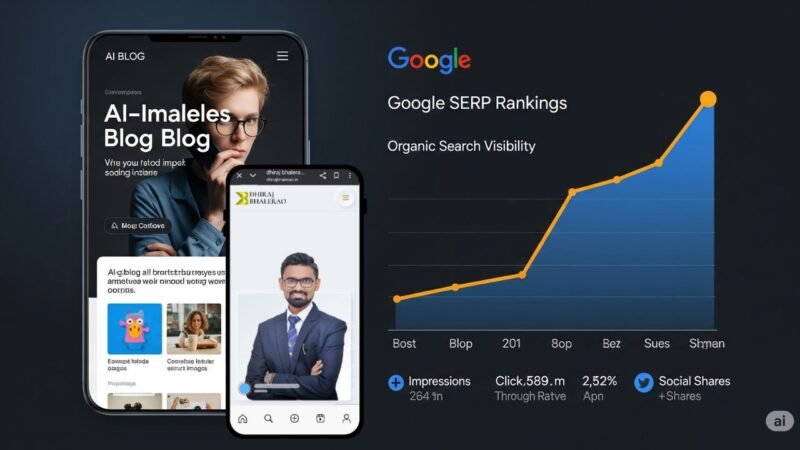
How to Rank on Google with AI-Optimized Content
Introduction
Ranking on Google is no longer just about keyword stuffing and backlinks. In the age of artificial intelligence, content that is both human-centric and machine-optimized is winning the SEO game. AI tools now help creators research, write, optimize and analyze content faster and more accurate. This blog will show you how to use AI strategically to get your website visible on Google.

What is AI-Optimized Content?
AI-optimized content is content created or enhanced using artificial intelligence tools to perform better in search engine rankings. This includes:
- Keyword and topic research
- Semantic optimization
- Content structure and formatting
- Performance prediction
- Continuous improvement based on data
Why AI Matters for SEO?
Google’s algorithms now favor E-E-A-T (Experience, Expertise, Authoritativeness, and Trust) and helpful content over keyword-loaded articles. AI tools like ChatGPT, SurferSEO.
help you to align with these goals by:
- Generating content that matches search intent
- Structuring content for readability
- Optimizing for LSI (Latent Semantic Indexing) keywords
- Improving content quality and consistency
How to Rank on Google Using AI
Use AI tools like Semrush + ChatGPT or Google Search Console + AI to find high volume, low competition keywords and search intent.
🧠 Prompt:
“Give me long-tail keywords for ‘AI in SEO’ with informational intent and high engagement potential.”
Create an SEO-friendly structure that includes:
- H1 with main keyword
- H2s for subtopics
- FAQs with schema-ready answers
🧠 Prompt:
“Create an SEO blog outline for the keyword ‘AI content optimization’ with FAQs and internal linking suggestions.”
Use ChatGPT to create content that reads naturally and matches tone and intent.
Make sure it’s:
- Informative
- Well-structured
- Unique✍ Tip: Use tool like Grammarly to refine clarity and readability.
AI tool like SurferSEO analyze top-ranking pages and suggest improvements in:
- Keyword density
- Heading usage
- Internal/external links
- Word count
Ask ChatGPT or plugins to create:
- Meta titles/descriptions
- FAQ schema
- Structured data
🧠 Prompt:
“Generate JSON-LD schema for a blog on AI content optimization with FAQs.”
AI can predict readability, time-on-page and user intent. Use it to:
- Rewrite intros for better hook
- Add CTAs in right places
- Optimize mobile readability
Use Google Analytics + AI reporting tools to track performance and recommend content refreshes.
🧠 Prompt:
“Analyze bounce rate and suggest why this blog isn’t ranking despite high impressions.”
Use AI tools like Semrush + ChatGPT or Google Search Console + AI to find high volume, low competition keywords and search intent.
🧠 Prompt:
“Give me long-tail keywords for ‘AI in SEO’ with informational intent and high engagement potential.”
Create an SEO-friendly structure that includes:
- H1 with main keyword
- H2s for subtopics
- FAQs with schema-ready answers
🧠 Prompt:
“Create an SEO blog outline for the keyword ‘AI content optimization’ with FAQs and internal linking suggestions.”
Use ChatGPT to create content that reads naturally and matches tone and intent.
Make sure it’s:
- Informative
- Well-structured
- Unique✍ Tip: Use tool like Grammarly to refine clarity and readability.
AI tool like SurferSEO analyze top-ranking pages and suggest improvements in:
- Keyword density
- Heading usage
- Internal/external links
- Word count
Ask ChatGPT or plugins to create:
- Meta titles/descriptions
- FAQ schema
- Structured data
🧠 Prompt:
“Generate JSON-LD schema for a blog on AI content optimization with FAQs.”
AI can predict readability, time-on-page and user intent. Use it to:
- Rewrite intros for better hook
- Add CTAs in right places
- Optimize mobile readability
Use Google Analytics + AI reporting tools to track performance and recommend content refreshes.
🧠 Prompt:
“Analyze bounce rate and suggest why this blog isn’t ranking despite high impressions.”

Results You Can Expect
-
Faster content creation -
Better alignment with search intent -
Improved SERP visibility -
Higher engagement and lower bounce rate -
Scalable content strategy
Conclusion
AI is not here to replace content creators—it’s here to boost creativity and precision. The key to ranking on Google with AI-optimized content is combining human insight with AI efficiency. Use the right tools, write with intent and let data guide your updates.

How ChatGPT is Changing Digital Marketing in 2025
What is ChatGPT?
ChatGPT is an advanced AI chatbot developed by OpenAI, capable of understanding and generating human-like text.
In digital marketing, it’s used to create content, answer customer queries, generate ideas, write emails, optimize ads, and more — all in seconds.
In 2025, ChatGPT has moved beyond being just a writing tool. It’s now your full-time virtual marketing assistant, powered by data and automation.
Analogy: ChatGPT as Your Smart Marketing Assistant
Think of ChatGPT like a young, energetic intern in your marketing team — but one who:
- Never sleeps 😴
- Understands your tone 🧠
- Writes like a pro ✍️
- Works at lightning speed ⚡
Let’s say you’re running a home decor store online. You need:
- Instagram captions
- Blog posts
- Email campaigns
- Product descriptions
- Replies to customer questions
You ask once, and ChatGPT delivers all this — in your voice, instantly.
That’s the AI advantage. It helps small teams or solo marketers do the job of five people.

How ChatGPT is Revolutionizing Digital Marketing
1. Content Creation
No need to hire 3 writers or wait for weeks. With ChatGPT:
- Blog posts can be drafted in minutes
- Social media captions tailored to trends
- Product descriptions written for every SKU
Example:
An Indian fashion brand uses ChatGPT to write 100+ product descriptions for its summer collection in just 2 days.
2. Customer Support Automation
Using tools like ChatGPT API + WhatsApp Business, brands now:
- Offer 24/7 chat support
- Solve basic queries instantly
- Reduce support costs by over 50%
Example:
An edtech startup uses ChatGPT to answer course-related FAQs on WhatsApp and save 30+ hours a week.
3. Personalized Email Campaigns
Marketers are using ChatGPT to:
- Draft engaging subject lines
- Personalize emails for each segment
- Create A/B testing variations quickly
Example:
A digital marketing freelancer sends 3 versions of the same campaign to different industries — all created in minutes using ChatGPT prompts.
4. Keyword & SEO Strategy
With the right prompts, ChatGPT can:
- Generate long-tail keywords
- Suggest blog topics based on current trends
- Draft meta descriptions and slugs
Example:
A startup founder uses ChatGPT to generate SEO-optimized content ideas for her beauty blog targeting Tier 2 Indian cities.
5. Ad Copy and Landing Page Optimization
ChatGPT helps craft:
- Google & Facebook Ad copy with proper CTA
- Landing page headlines and benefits sections
- Scripts for promotional videos
Example:
An Indian D2C brand improves ad CTR by 32% after rewriting ad copy using ChatGPT’s persuasive writing prompts.

Future Scope of ChatGPT in Marketing (2025 & Beyond)
- Voice & Video Integration: AI-generated video ads and voiceovers for YouTube & Instagram
- E-commerce Integration: Product recommendations, chat-assisted checkout, and upselling
- WhatsApp/Instagram DM Automation: Conversational marketing that feels human
- Campaign Reporting & Analysis: Automated analytics summaries in natural language
- Prompt Libraries: Ready-made ChatGPT prompts for every marketing use case
As it continues to evolve, marketers who learn prompt engineering will lead the future.
Summary
- ChatGPT is more than a chatbot — it’s your smart marketing co-pilot.
- Saves time, reduces costs, and increases content quality.
- Perfect for freelancers, startups, and agencies in India.
- Future-proof your marketing strategy by learning how to use it effectively.

Predictive Analytics in 2025: What Digital Marketers Must Know
What is Predictive Analytics?
In simple words, Predictive Analytics is a technique that uses past data, artificial intelligence, and algorithms to predict future actions.
In the world of digital marketing, it helps you answer questions like:
- Who is likely to buy your product?
- When is the best time to send an email?
- Which users are about to unsubscribe?
It’s like turning your data into a crystal ball!

Analogy
The Smart Shopkeeper in an Indian Bazaar
Imagine you’re a shopkeeper in a bustling market like Delhi’s Chandni Chowk or Pune’s Laxmi Road. Now, let’s see two types of shopkeepers:
Regular Shopkeeper
- Stocks everything
- Sells to anyone
- Guesses what might sell
Sometimes it works, but often he wastes money on things nobody buys.
Smart Shopkeeper with Predictive Power
- Remembers customer preferences
- Predicts festive demands (Diwali, Eid, Holi)
- Sends WhatsApp offers to customers who are likely to visit
This smart shopkeeper always has the right stock, right offers, and happy customers.

Real-Life Examples for Marketers
Example 1: Facebook Ads Campaign
You own an online saree boutique. Instead of showing the same ad to everyone:
- Predictive tools show ads with “Silk Saree Offers” to people who browsed wedding collections.
- Younger audience sees “Office-Ready Sarees Under ₹999”.
Result: More clicks, less waste, better sales.

Example 2: Email Marketing for a Coaching Institute
You send emails about new courses:
- Students who clicked on SEO blogs earlier now receive SEO course invites.
- Students who haven’t opened your emails in 30 days receive a special ₹500 discount.
Result: Higher open rates and more enrollments.

Future Scope of Predictive Analytics in India (2025 & Beyond)
💬 WhatsApp Business + Predictive AI: Smart replies based on user queries
🛒 E-Commerce Personalization: Amazon-style recommendations for small Indian brands
🎓 EdTech Platforms: Predict student dropouts and offer personalized nudges
💳 Fintech Apps: Suggest saving plans based on user’s past spending
🏥 Healthcare Marketing: Predict when someone might need a health checkup
The demand for data-savvy digital marketers is growing rapidly. If you know how to use predictive analytics, you’re already ahead!
Summary
✅ Predictive Analytics = Data + AI = Future Planning
✅ Helps you target the right person, at the right time, with the right message
✅ Boosts ROI, saves time, and improves customer experience
✅ Perfect for Indian marketers dealing with large audiences across different regions
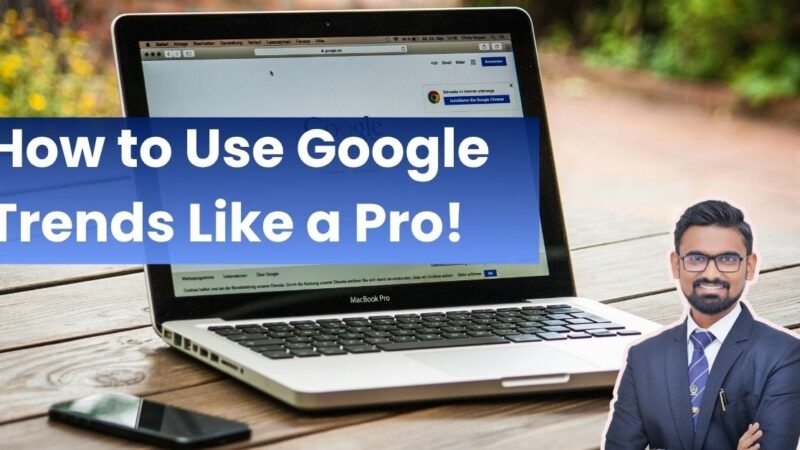
Unlock the Power of Google Trends: A Smart Tool for Marketers & Content Creators
In today’s fast-paced digital world, the word “trend” is more relevant than ever. From the latest fashion to viral songs and emerging technologies, trends shape how people consume content—and most importantly, how they search for it online. That’s where Google Trends comes in—a free and powerful tool that helps you uncover what the world is searching for in real time.
Whether you’re a content creator, digital marketer, blogger, or business owner, understanding how to use Google Trends can give you a competitive edge. Let’s explore what this tool offers and how you can use it effectively.
What is Google Trends?
Google Trends is an online tool provided by Google that allows you to analyze the popularity of search queries across regions and over time. It provides insights into what’s trending on Google Search, helping you stay updated and make smarter content or marketing decisions.
Key Features of Google Trends
- Search by Country or Region
- Google Trends lets you filter results based on specific countries or even subregions. This is especially helpful if you’re targeting a local or regional audience.
- Compare Search Terms
- Want to know whether “digital marketing” is more searched than “social media marketing”? Google Trends offers comparison graphs that visually show the popularity of multiple terms over time.
- Time-Based Analysis
- You can view data over various time frames—past hour, day, week, month, or even years. Custom date ranges allow for flexible analysis depending on your needs.
- Category-Specific Search
- If you’re looking for trends in a particular industry, you can narrow results by categories such as Health, Business, Arts, or Technology. This makes your search more relevant and focused.
- Search by Type
- Google Trends lets you explore how a term performs across different platforms—Web Search, Image Search, News, Google Shopping, or YouTube.
- Related Topics & Queries
- Get suggestions for topics and search queries that are either rising in popularity or already at the top. For example, searching “laptop” might also show trending searches like “laptop accessories” or “best budget laptops.”
- Interest by Subregion
- You can explore how interest in a topic varies across cities, states, or regions within a country—ideal for local SEO and market research.
How to Use Google Trends Effectively
Imagine you’re planning a blog post on digital marketing. By using Google Trends:
- You can check which cities in India have the highest interest in the term.
- Filter the results by the last 30 days to spot fresh trends.
- Discover related queries like “digital marketing courses” or “SEO tips.”
- Narrow down results to the Business category for more accurate insights.
- Compare it with other keywords like “influencer marketing” or “email marketing.”
This helps you pick the right topic, identify trending keywords, and publish content that resonates with your audience.
Why It Matters
In digital marketing, timing and relevance are everything. Google Trends enables you to make data-driven decisions—whether it’s writing a blog, optimizing for SEO, planning a video, or launching an ad campaign. It removes guesswork and offers real-time insights that help you stay ahead of the curve.
Best of all? It’s completely free and requires no sign-up. The interface is user-friendly, making it easy even for beginners to explore and use.
Final Thoughts
If you want your content to be relevant and discoverable, Google Trends is a must-have in your digital toolkit. From identifying trending topics to boosting SEO and improving user engagement, this tool offers immense value at zero cost. Start using it today and watch your digital presence grow!
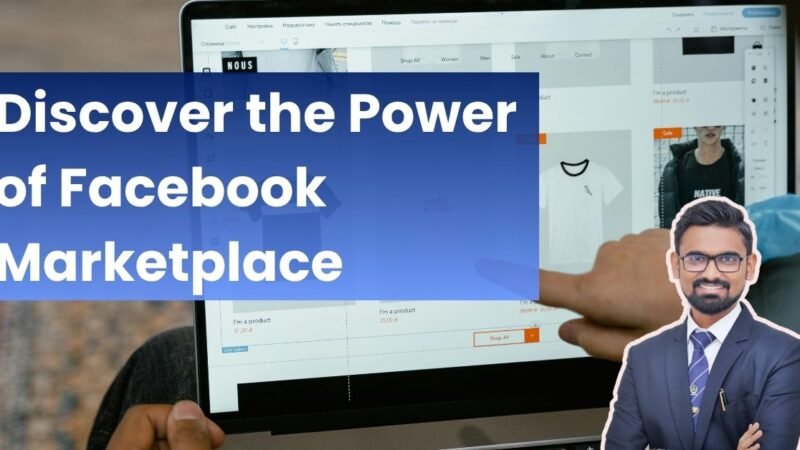
Everything You Need to Know About Facebook Marketplace
In today’s digital age, online marketplaces have become an essential part of how we buy and sell products. From global platforms like eBay to local favorites like OLX and Quikr, the shift from traditional to online shopping has been significant. One platform that’s gaining rapid popularity is Facebook Marketplace—a feature within Facebook that allows users to buy and sell products within their local area.
What is Facebook Marketplace?
Facebook Marketplace is a convenient and user-friendly platform where individuals and small businesses can list, browse, and purchase items. Integrated directly into Facebook’s interface, this tool enables users to connect with buyers or sellers in their community without needing a separate app or website.
Key Features of Facebook Marketplace
- Completely Free to Use
Facebook Marketplace does not charge any listing fees. Users can post as many items as they like without worrying about additional costs. - Buy & Sell New or Used Items
Whether you’re clearing out your garage or launching a home-based business, Facebook Marketplace supports the sale of both new and used goods. - Easy Listing Process
Creating a listing is simple. Just upload product photos, add a description, set your price, and choose a category—your product is live within minutes. - Image-Driven Listings
Visual appeal matters. You can upload multiple images of your product, making it easier for buyers to understand exactly what they’re getting. - Category & Location Filters
Buyers can browse items by category and location, helping them find relevant listings in their area. Sellers can also set a specific radius to target nearby buyers. - Large User Base
With over 550 million users accessing Facebook Marketplace every month, your product can reach a vast audience, giving sellers a better chance of quick conversions.
Why Facebook Marketplace is Great for Small Businesses
If you don’t yet have a website or e-commerce store, Facebook Marketplace can act as your online storefront. It’s especially helpful for local and small-scale businesses looking to gain visibility without incurring high advertising costs. Because users are already familiar with the Facebook platform, it reduces the learning curve and builds trust.
Important Guidelines and Limitations
While the platform offers many advantages, Facebook has strict policies regarding what can and cannot be sold. Prohibited items include:
- Illegal drugs
- Weapons
- Live animals
- Counterfeit goods
- Stolen or pirated content
Failure to comply can result in your listings being removed or your account being blocked. So, always be transparent and honest in your product descriptions.
Security Concerns and Areas of Improvement
Despite its popularity, Facebook Marketplace does have some limitations. Since Facebook doesn’t facilitate the actual transaction, users must arrange payment and delivery independently. This opens the door to scams, misleading ads, or incorrect pricing—often seen in listings marked at ₹1 just to grab attention.
Additionally, concerns over privacy and data security persist. Hacking incidents and unauthorized access to private chats can shake user confidence. Facebook must continue to improve its security features and crack down on counterfeit listings to ensure a safer experience.
Final Thoughts
Facebook Marketplace is an excellent tool for individuals and businesses to connect over products in a local setting. It’s easy to use, free, and widely adopted. However, buyers and sellers must exercise caution, follow community guidelines, and practice secure transactions. As Facebook continues to enhance the platform, we can expect even better features and stronger protections in the future.

Facebook Ads: The Smarter, More Human Way to Reach Your Audience
Let’s be honest—we all want our marketing efforts to feel more personal and less like spam. Take this example: A coaching class wants to promote its entrance exam program. They print hundreds of pamphlets and hand them out near colleges. Some reach genuinely interested students or their parents, but most go unnoticed—or become paper planes in a classroom.
That’s the problem with traditional marketing. It doesn’t always speak to the right people.
But what if your message could reach only those who actually care? With Facebook Ads, it can. It’s like handing your pamphlet to someone who’s already searching for what you offer—and doing it in a way that feels natural and relevant.
What Are Facebook Ads?
Facebook Ads is Facebook’s paid advertising platform that allows businesses to create and display ads directly to a targeted audience. Whether you’re a local coaching class, a bakery, or a tech startup, you can build campaigns that match your business goals—and reach people who are more likely to care about what you have to say.
Unlike cold pamphlet handouts, Facebook Ads offer a more personal, data-driven, and engaging experience.
Why Facebook Ads Feel More Human (and Work Better)
1. 🎯 Set Clear Objectives Based on Your Real Goals
Facebook lets you select what you want to achieve. Whether it’s:
- Brand Awareness
- More Website Visits
- App Downloads
- Video Views
- Engagement
- Leads or Conversions
You’re not just running an ad—you’re starting a conversation with the right people for the right reasons.
2. 👥 Talk to the Right People
With Facebook Ads, you don’t waste your message on the wrong crowd. You can filter and focus:
- Location: Want to reach students in Kurla, Mumbai? You can zoom in that specifically.
- Age & Gender: If your program is for 16–25-year-olds, no problem.
- Language: Choose the languages your audience speaks.
- Interests & Behavior: Facebook knows what people like based on their activity. You can target users who already engage with similar pages or topics.
This kind of targeting helps you speak to people as individuals, not just numbers.
3. 📍 Choose Where Your Ads Appear
You can let Facebook decide the best placements (like Facebook Feed, Stories, Instagram, etc.) or choose manually. It’s flexible—and that means your message shows up where it feels the most natural.
4. 💰 Control Your Budget and Schedule
You don’t need a huge marketing budget. You can set a daily or lifetime budget, and decide when your ads run—whether it’s a short burst before exam season or an ongoing presence to build awareness.
5. 🖼️ Use Formats That Match Your Message
Whether it’s a single image, a carousel of multiple visuals, or a short video that tells your story, Facebook Ads lets you express yourself in a way that’s visually appealing and emotionally engaging.
Final Thoughts
People don’t want to be “marketed to”—they want to be understood. And that’s what makes Facebook Ads so powerful. They help businesses of all sizes connect with people in a more thoughtful, targeted, and human way.
There’s no perfect recipe for success, but that’s okay. The key is to test, learn, and grow. Avoid shortcuts like blackhat tactics. Focus on honest connections, clear messaging, and genuine value.
Because at the end of the day, your audience isn’t a number—it’s a real person looking for real solutions. So be human. Be helpful. And let your marketing do more than sell—let it connect.




